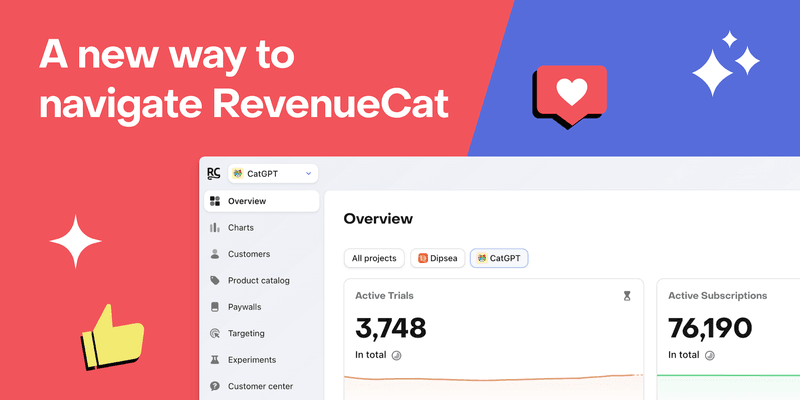Summary: RevenueCat’s dashboard navigation has a new look and it’s now live. The update introduces a vertical layout, promotes Projects to a top-level view, and simplifies tool access across Web, Paywalls, and Customer center. We’re rolling it out starting today. You can still switch back for a limited time.
We’ve redesigned how you navigate RevenueCat. The new layout is cleaner, more scalable, and designed for how real teams work. Whether you’re switching projects, exploring charts, or working in tools like Paywalls or Customer center, everything’s easier to find — with less friction.
New navigation is now rolling out
We’ve rolled out the updated dashboard navigation for everyone. You can still switch back to the previous layout for a limited time.
Your feedback helped shape this update — and we’re still listening. If something doesn’t feel right or you have ideas to improve the experience, let us know. Share feedback →
What’s different
Vertical layout
More space, especially on smaller screens. A more consistent experience across tools.

Projects are now top-level

Clearer structure, fewer clicks
Faster access to the thing you switch between most.
Customers and Charts are easier to find and shown in the context of the project.

Built to grow
This layout scales with us, so we can add new features without adding clutter.
Why we made the change
The old navigation worked, but only up to a point. As RevenueCat grew, the dashboard became harder to navigate. Features were added, workflows evolved, and what once felt simple started to feel scattered.
We heard the same things again and again:
“I didn’t know that feature existed.”
“It takes too many clicks to switch projects.”
“Navigation feels inconsistent across tools.”
It became clear that the structure wasn’t scaling with our product, or your needs. Tools were buried. Key actions were hard to find. And the experience varied too much between sections.
This redesign is our response. It brings a clearer hierarchy, faster access to what matters, and a layout that can grow with you. We’ve built it to support teams working across multiple products and platforms, and to reduce friction every step of the way.
FAQ: New navigation
What changed in the Overview page?
You’ll now find an Overview section for each project, making it easier to focus on the project you’re working on, and still have an Overview with data from all of your projects in one place.
Can I still see charts across all projects?
Yes. Cross-project charts are still available via the Explore all charts button on the home screen.
How do I switch between projects now?
Use the project pills at the top of the screen or the project selector in the sidebar to jump between projects quickly.
What’s changed inside the project view?
We’ve replaced the old structure with a vertical menu for a cleaner, more scalable layout.
Where are Charts and Customers now?
They now live inside each project, so your context stays consistent.
Collapse the submenu to focus on just the section list — great for small screens or focused work.
What happened to the old “Apps” landing page?
It’s been replaced by Platforms, a more organized way to manage your integrations and keys.
Where are my API keys?
API keys now live under Platforms.
What’s in the new Product Catalog?
The Product Catalog now includes Products, Offerings, Entitlements and Virtual Currencies—everything you need to manage monetization in one place.
Can I change the app’s accent color?
Yes! Go to Account Settings > Interface to customize the theme tint. If you don’t want to use the app icon color, you can override it there.
How can I switch back to the old navigation?
You’ll find it under the Help icon or in Account settings > Interface.


